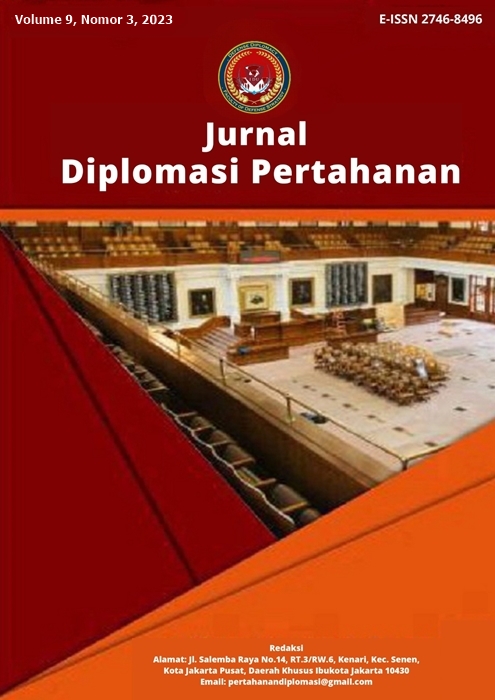THE ROLES OF ASEAN IN BUILDING A STRATEGIC EQUILIBRIUM WITH MAJOR POWERS TO STRENGTHEN SUSTAINABLE STABILITY, AND MARITIME SECURITY IN THE REGION
DOI:
https://doi.org/10.33172/jdp.v9i3.14513Abstract
The Association of Southeast Asian Nations (ASEAN) was founded in 1967 with a commitment to fostering socio-economic development and regional stability in Southeast Asia. Over the years, ASEAN has maintained its dedication to peace, stability, and mutual development amidst a changing geopolitical landscape. This article explores ASEAN's pivotal role in establishing a strategic equilibrium with major global powers to ensure sustainable stability and maritime security in the Indo-Pacific region. To analyze ASEAN's role, the research methodology section explains the qualitative research approach used in this study. The primary objective of this research is to elucidate the strategies and mechanisms ASEAN employs to strike a balance with major powers. The discussion section delves into the strategic environment and challenges in Southeast Asia, covering maritime security, environmental vulnerabilities, and issues like drug trafficking and cybercrime. ASEAN's geopolitics are examined, highlighting the region's economic growth and its role as a focal point for strategic rivalry among major global powers. The Indo-Pacific dynamics, particularly ASEAN-China economic relations, and the Belt and Road Initiative, are discussed, emphasizing their implications for maritime security. The conclusion that can be drawn from this paper is ASEAN's role in building strategic balance with major countries to strengthen sustainable stability and maritime security in the region.References
Acharya, A. (2013). The Making of Southeast Asia: International Relations of a Region. Ithaca: Cornell University Press.
Buszynski, L. (2015). The South China Sea Maritime Dispute: Political, Legal and Regional Perspectives. Routledge.
Capie, D. (2014). Between a Hegemon and a Hard Place: The 'ASEAN Way' in the Age of Pivot. Journal of Contemporary Southeast Asia.
Chen, R. (2022). The BRI and ASEAN: Roads to Development. Pacific Development Review.
Chen, R. (2022). The BRI and ASEAN: Interlinking Economies. Pacific Affairs Journal.
Jones, L. & Smith, M. (2017). ASEAN's Unchanged Melody? The Theory and Practice of Non-Interference in Southeast Asia. Cambridge University Press.
Jones, A. & Smith, B. (2022). "Trade Dynamics in the Indo-Pacific". International Economic Review.
Lee, H. (2018). Drug Dynamics in Southeast Asia: Underground Routes. Regional Security Journal.
Lee, H. (2022). Maritime Dynamics in the Indo-Pacific. Oceanic Affairs Quarterly.
Nguyen, T. (2019). Cyber Threats in ASEAN: Digital Shadows. Cybersecurity Review.
Nguyen, P. (2021). ASEAN's Maritime Security Conundrum. Journal of Southeast Asian Naval Strategy.
Nguyen, L. (2023). Cyber Rivalries: US-China Relations. Tech and Geopolitics Digest.
Rajaratnam, S. (2020). ASEAN and the Major Powers. Geopolitics Journal of Southeast Asia.
Santoso, D. (2023). Environmental Challenges in the Indo-Pacific. EcoAsia Journal.
Severino, R. C. (2006). Southeast Asia in Search of an ASEAN Community. Institute of Southeast Asian Studies.
Smith, D. (2015). Maritime Security in Southeast Asia: Navigating Troubled Waters. Global Maritime Studies.
Smith, J. & Lee, H. (2019). Maritime Trade and Naval Logistics in the Indo-Pacific. Maritime Affairs Quarterly.
Sutanto, R., Priyanto., & Adriyanto, A. (2022). Naval and Maritime Strategy. Jakarta; Unhan Press.
Wang, L. (2023). China-ASEAN Relations: Converging Paths. Asian Diplomacy Journal.
Wang, L. (2023). China's Diplomatic Strategies in the Indo-Pacific. Asia-Pacific Review.
Watson, R. (2017). Ecosystems at Risk: Southeast Asia's Maritime Challenge. Oceanic Perspectives.

